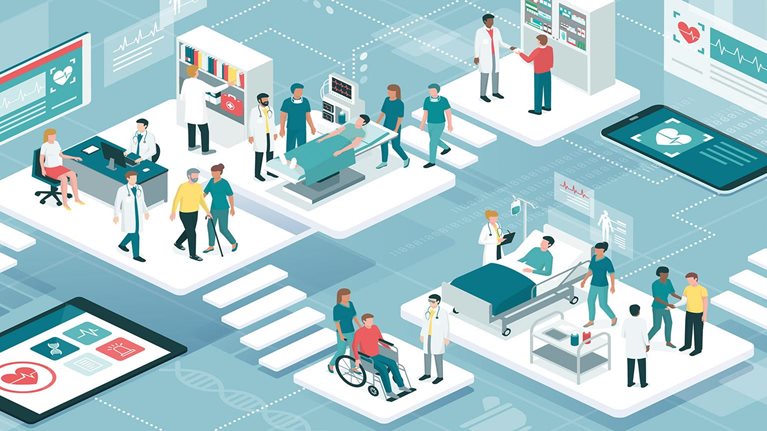Unlocking speed in times of crisis
The COVID-19 crisis has challenged organizations across industries and sectors, forcing leaders to rethink how they organize, make decisions, serve customers, and interact with their employees. The healthcare industry has combatted the pandemic on a variety of fronts. Through mobilizing clinicians, adapting sites of care, launching new services at speed and, as always, prioritizing the health and well-being of patients, players across the healthcare industry strove to meet the challenge of a one-in-a-generation crisis. Some examples of success in North America noted by healthcare leaders include:
- One health system mobilized 4,500 providers for telehealth offerings, scaling from around 500 daily video visits to roughly 150,000 daily visits in three months
- A health services organization was able to achieve a radically faster product development cycle to go from concept to launch in under three months
- A care delivery organization drastically sped up decision making, taking capital equipment decisions from the 60 to 90 days it historically took to a matter of two weeks, and other supply decisions from 30 to 45 days to only one week
In McKinsey’s recent Global Leadership Survey which included more than 850 senior executives from nine industries, healthcare leaders indicated that throughout this crisis, they have made significant improvements in the way they communicate with employees, their organizations’ culture and purpose, and their ability to drive execution and accountability and make decisions at speed (Exhibit 1).

Would you like to learn more about our Healthcare Systems & Services Practice?
Challenges faced by healthcare organizations in locking in speed for the long term
However, it is not an entirely rosy picture. Responses to the same survey, conducted in 2020, also highlighted substantial negative impacts from COVID-19 on stability of business, productivity, and ability to meet the needs of stakeholders. This was most acutely felt by hospitals and other care providers.
As more people become vaccinated, reducing the acute, short-term demands of COVID-19 on our healthcare system, healthcare organizations may be better situated to address the longer-term implications that COVID-19 has accelerated or brought to light, including:
- Creating a more resilient and flexible healthcare ecosystem capable of adapting to changes in demand (for example, rapid decline in inpatient services, shift of care from hospital to ambulatory setting, and uncertainty around future surges/outbreaks), including developing the ability to move resources (for example, facilities and people) dynamically based on health needs such as the reforms explored in “The great acceleration in healthcare: Six trends to heed.”
- Considering the long-term implications of a sudden expansion of virtual health and other remote activities, such as those explored in our telehealth and virtual health articles.
- Ramping up use of technology and innovative staffing models to enable clinicians to continue to operate at the top of their licenses, as discussed in “The productivity imperative for healthcare delivery in the United States.”
Looking to the future, healthcare leaders anticipate significant changes across wide-ranging facets of the way they operate, at higher rates than leaders in other industries (Exhibit 2).

The ability to react more quickly to changes in the market is the number one reason cited by healthcare leaders to change, followed by cost reduction and productivity. However, healthcare leaders pursuing these aims face significant headwinds, from silos and lack of coordination to resistance to change and a lack of strategic clarity and a number of other factors (Exhibit 3).

- One leader notes, “Once COVID-19 eventually ends (and it will end), I worry that people will lose their urgency and go back to the old way of doing business because the crisis will be over.”
- Another healthcare leader shared, “We are still very hesitant at times to take risk with new models and make transformational leaps. Healthcare is getting forced to do this but none of us are moving that quickly.”
- Several leaders indicated concerns about their ability to attract and retain talent if they do not enable remote work when other industries are making this more of a permanent fixture, as well as ensuring high-quality collaboration and decisions where they do introduce remote work.

What employees are saying about the future of remote work
Embedding sustainable speed
How can healthcare organizations overcome these obstacles and redesign to move at speed and increase impact? A number of healthcare leaders point to new capabilities and ways of working that have enabled their improved ability to make decisions and move at speed as a result of COVID-19:
- Delegating decision making: A provider organization leader shared that their frontline staff have been given more authority to make decisions to allow for more nimble execution of needed work.
- Breaking down siloes and improving collaboration: A health services leader noted, “I work in a large conglomerate where the different divisions historically have resisted working with each other. In the COVID-19 crisis, we’ve effectively put together teams from across the different divisions to rapidly introduce new products to market. I’ve never seen barriers fall so quickly and people who never knew each other start working together so quickly.”
- Adopting more agile ways of working: Another health services leader flagged that they have moved from perfecting solutions before launching to launching an initial “version 0” and making changes as they go.
- Dynamically deploying talent: An HR leader at a provider indicated that they implemented a personnel pool to redeploy talent to meet the COVID-19 demand. Another leader highlighted that they “got serious with labor productivity, which we had never before done. Nearly all of my staff including my direct reports have at least one productivity performance indicator and in some cases there are three. We used these indicators to determine how we staffed our business since much of our patient volumes declined. We are back at our normal volume rate but we still manage our staffing in this way.”
Looking forward, survey respondents noted several changes to catalyze greater organizational speed, including flattening the organization, empowering leaders closer to the work to make decisions, creating clarity and alignment around common objectives and milestones, maintaining the ability to collaborate effectively in remote or hybrid models, and improving access to and disseminating data across the enterprise.
Healthcare leaders have shown their mettle during the COVID-19 crisis. As life slowly turns to the “next normal,” the next six months offer a chance to harness the energy and passion stemming from breaking down silos, collaborating effectively, and taking a philosophy of trying an “early version” rather than waiting for perfection. By looking holistically at work, organizational structure and talent, leaders can sustainably design a healthcare organization for speed.


